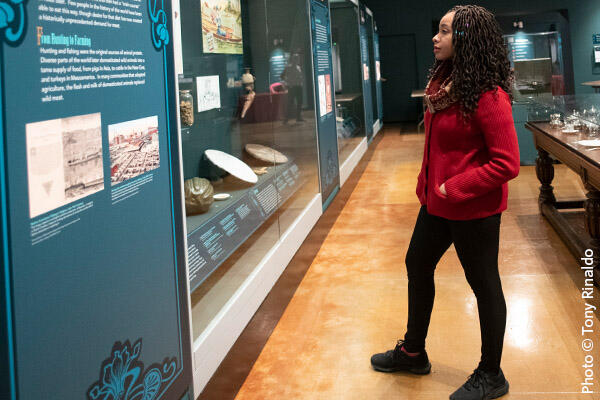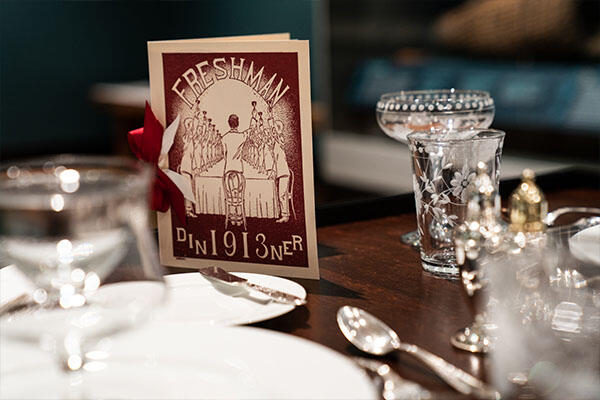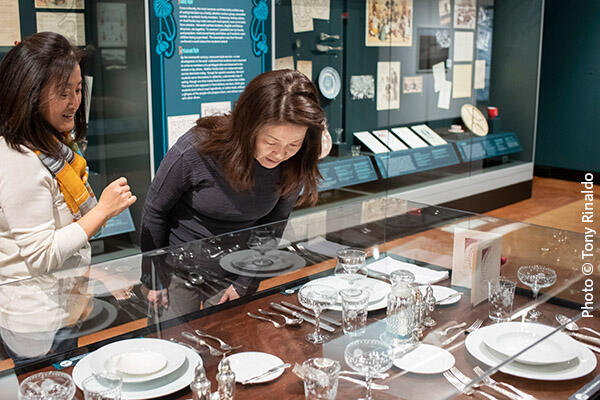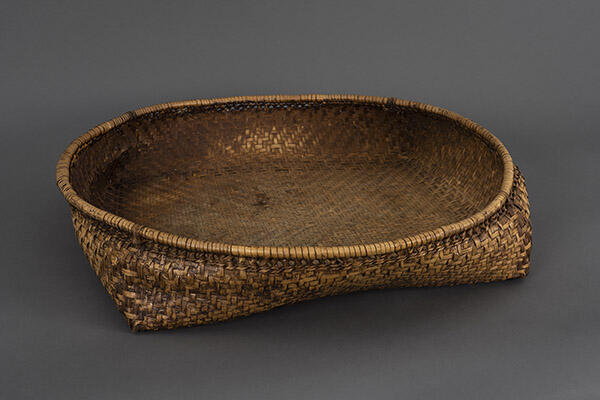


"Harvard’s Peabody Museum exhibit makes museumgoers see their own eating and cooking in a different light"—Boston Globe
"...the exhibition explores inclusion and exclusion in American history, as well as the social, political, economic and technological influences on the way Americans have eaten."—New York Times

|
Ongoing exhibitionFood has long been a uniquely powerful measure of social inclusion: Who gets to eat oysters or drink champagne, and how might these privileges change over time? |
|
One dinner served in 1910 forms the centerpiece–literally–of Resetting the Table: Food and Our Changing Tastes. During this high-end restaurant meal, the probably all-male, and likely all-white, Harvard freshmen were served Cotuit Cocktail, beef, imported champagne, and an elaborate Eastern European cake called “Mocca Tree.” Cigarettes were also on the menu. Radcliffe “ladies” were not invited, enabling the young gentlemen to smoke freely, according to the social norms of the day. |

|

|
Resetting the Table explores food choices and eating habits in the United States, including the sometimes hidden but always important ways in which our tables are shaped by cultural, historical, political, and technological influences. |
|
Visitors encounter a great oak dining table set for each course of the formal meal prepared for the freshmen, who were soon to be caught up in the global conflict of World War I. The historical and cultural roots of each set of foods on the menu, and the privileged context of their presentation, are explored with displays of original objects in the surrounding cases. |
|
|
|
Archaeological and historical collections reveal the long history of many iconic American foods, across multiple cultures and thousands of years. These objects include prehistoric oyster shells, turkey bones, and an intricately fashioned nineteenth-century eel pot from New England. Stunning Central American tools and ceramics signal the New World origins of corn and chocolate. The foodstuffs introduced to North America from other parts of the world include sugar, coffee, rice, and grape wine. Consumption of these foods, however, was never universal. |
|
As visitors make their way through the exhibition, they encounter a life-sized diorama of an early twentieth-century kitchen designed to show what happens before any food is consumed—the tools, traditions, and skilled work of food preparation that have always put food on the table. The kitchen introduces objects of food preparation from around the globe. Featuring many unusual items, some never on public display, Resetting the Table offers a fresh—sometimes surprising—window into our attitudes toward food, examined through the lens of objects used in its production, preparation, and consumption through time and across cultures. |
|
|
|
Guest curator and Harvard University James Duncan Phillips Professor of Early American History Joyce Chaplin joined the Peabody Museum of Archaeology & Ethnology in an extensive survey of the museum’s collections and those of nine other Harvard University collections. The resulting exhibition features a rich array of food-related objects and their stories, spanning thousands of years and going all around the world. |
Mini ExhibitRice: Seeds from Africa examines the legacy of rice cultivation in the Americas. Set within the Resetting the Table exhibition, this new mini exhibit explores the essential African knowledge systems required to establish what became a thriving industry, the horrific human toll the Atlantic Slave Trade took to maintain it, and the vibrant, enduring culture of the Gullah Geechee, descendants of enslaved Africans whose basket making and coastal subsistence traditions continue today. Watch a silent video from the "Rice: Seeds from Africa" mini-exhibit of master basket maker Mrs. Yvonne Grovner of Sapelo Island, Georgia demonstrating her technique. |

|
Listen to a podcast with the curator, historian Joyce Chaplin. Read the podcast transcript for "Food and Status: A Discussion with Historian Joyce Chaplin."
Listen to a podcast with the museum's Curator of African Collections Sarah Clunis. Read the podcast transcript for "Healing the Scars of the Past: A Conversation with Sarah Clunis, Curator of African Collection at the Peabody Museum of Archaeology and Ethnology."
Listen to a podcast with Gullah Geechee basket maker Mrs. Yvonne Grovner. Read the podcast transcript for “Reflecting on Geechee Traditions with Master Basket Maker, Yvonne Grovner of Sapelo Island, Georgia.”
Watch the related panel discussion "Does Food Have a Gender?" with food historian Barbara Haber, chef, restaurateur, and entrepreneur Lydia Shire, moderated by Louisa Kasdon, CEO and Founder of Let’s Talk About Food.
See the related 3D interactive Resetting the Table exhibition with reflections on foods and foodways by talented teens from Chelsea and Somerville, Massachusetts as part of the Hear Me Out/Escuchame project.
Mira este recorrido 3D por la exhibición Resetting the Table con reflexiones sobre comidas y modos de comer. Hecho por talentosos jóvenes de Chelsea y Somerville, Massachusetts como parte del proyecto Hear Me Out/ Escúchame.
Top: detail of Syrian coffee pot. Gift of Herbert de Roth, 1920, 20-33-60/D1465. Below: Dried and partly smoked herring, early 20th-century. Gift of Robert Kornfeld, 1939, 39-42-10/18404. Rice winnowing basket, Gift of Frederick R. Wulsin, 29-4-50/H878.